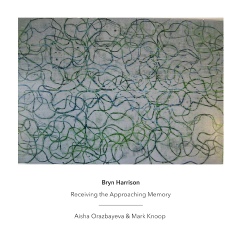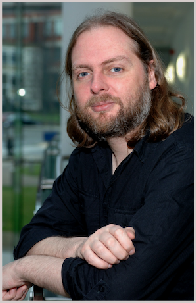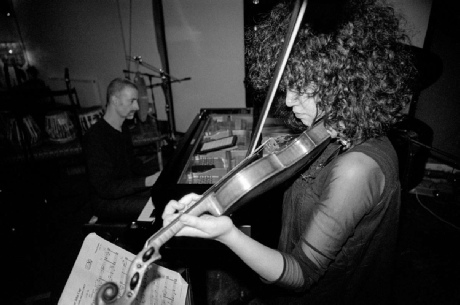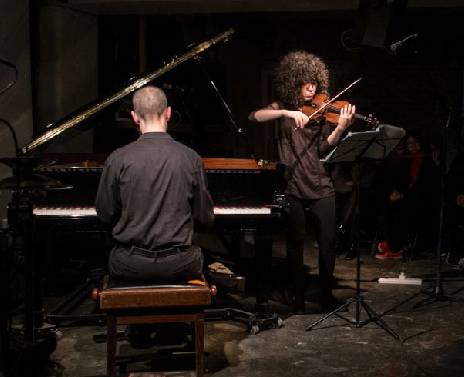Another Timbre TimHarrisonbre

at96 Bryn Harrison - ‘Receiving the Approaching Memory’
A composition in five movements for violin and piano
Aisha Orazbayeva (violin) & Mark Knoop (piano)
Interview with Aisha Orazbayeva & Mark Knoop
What drew you both to Bryn Harrison's music, and what would you say are its strengths?
MK: I came to Bryn's music through Matthew Shlomowitz and Joanna Bailie, the directors of Plus Minus Ensemble, who asked Bryn to write a piece for the ensemble's very first concert, in 2003. That work, 'Rise', immediately attracted me by the way it created an immensely detailed surface texture that still allowed for great clarity in the form and direction of the piece. Since then, Bryn wrote us another, much longer work, 'Repetitions in Extended Time', which takes both these aspects even further: extremely high levels of local detail serving an almost monolithic global form.
AO: My first encounter with Bryn’s music was ‘Leaf Falls on Loneliness’ which I performed with the Ossian ensemble in 2010. The piece made an impression and stayed with me for a long time. When Mark told me that there’s a long piano and violin piece I jumped at the opportunity to perform it. In his music I feel like Bryn introduces another world, but one that we cannot see at first, and the repetitions are the way to get closer to it so that every time the music repeats the world comes closer and closer to us, revealing its colours, shapes and architecture.
There is obviously a long history of compositions for violin and piano, and it’s probably either impossible or foolish for contemporary composers to ignore or forget that tradition. Do you think that in a way that is part of what we are ‘receiving’ when we listen to Bryn’s ‘Receiving the Approaching Memory’? How do you feel the work relates to or diverges from the tradition of classical violin sonatas?
AO: I don’t really see this as a ‘violin and piano’ piece in the traditional sense, I feel like it’s more about the sound, texture and form of the piece rather than the instruments. It’s highly virtuosic at the same time, but that aspect is not at the forefront, the difficulties are hidden from the listener and the performers are somehow hidden too.
MK: I had not considered that interpretation of the title, although it’s an interesting thought. Whilst Bryn’s music is of course influenced by the canon (as is all music), I don’t see him as a composer who is primarily engaged with reinterpreting that tradition. Having said that, a parallel could be made between the tonal structure that underpins sonata form and the way tonality develops through ‘Receiving the Approaching Memory’. The piece is in five sections: in the first, both instruments’ pitches are drawn from a complete chromatic pitchset. In subsequent sections, different pitches are removed from each instruments’ part so we have fewer common pitches (just C and F in the final section). Whilst I don’t think this is consciously perceived as “tonal” development by the listener, it certainly creates a subconscious sense of progress in what is otherwise essentially static music.
You recorded the piece in the famous Sendesaal at Bremen radio. How did that come about, and did it feel like a special venue?
MK: I’ve been aware of the hall for a while, and recorded and performed there several times in the last few years. It was built in the fifties and features a mid-size hall with an exceptionally clean acoustic, suspended on springs and isolated from the exterior of the building. This acoustic was ideal for Bryn’s music, giving the necessary clarity for the detail of the piece without becoming clinical or dry.
AO: I’d never performed in the hall before, but it was a joy to play and record there, and felt like a very special venue.
Both of you have moved to the UK from elsewhere, and I wondered how you both saw the experimental music scene here? Are there aspects that you feel are particular to this country, and are there any features which you regard as particular strengths or weaknesses?
AO: I left Kazakhstan when I was a teenager and back then my only violin preoccupations were to do with good intonation and drawing a straight bow. I became aware that there is an experimental music scene at all, not just in London, after I realised the formal violin training that I had since I was four was often not about the music, but a certain prescribed way of performing a certain prescribed repertoire. When I began studying with Clio Gould my focus gradually started to shift from achieving a perfect result to the process of discovering new ways of making music and a more personal relationship with the instrument. This change in the way I thought about music led me to discover the experimental scene in the UK, so far it’s the only one I’ve experienced.

Aisha Orazbayeva & Mark Knoop in performance at Cafe Oto
Photo: Dmitri Djuric
Bryn Harrison
Reviews
“If you don’t know the deft and gossamer music of Bryn Harrison, this album would be a beautiful place to start. The Bolton-born 40-something fits broadly within a British contemporary music bent for clever, subtle minimalism – his own heroes are Feldman, Messiaen, Skempton. There is, though, something especially economical and fantastical about Harrison’s sound; something in the way he repeats and interlocks fine-grained, shimmering material and keeps us spinning in a magical place between stasis, flux and momentum. He wrote Receiving the Approaching Memory for violinist Aisha Orazbayeva and pianist Mark Knoop in 2011 and they do it marvellous justice: violin lines flit about, birdlike, against a glittering piano backdrop, both instruments sounding as quiet and urgent as a whisper made on an inhalation. Orazbayeva is a taut and boisterous player who doesn’t let a single note rest: this music might be repetitive, but every moment is alert, agile and ready to take flight.”
Kate Molleson, The Guardian
“I won't forget the new "Receiving the Approaching Memory" for a long time. It's a wonderful piano/violin duo, a long dream, near of speech, constructed on melodic repetitions and a very creative use of violin. Highly recommended.”
Julien Heraud, Improv-Sphere
“It is one thing to receive something, and quite another to know just what to do with it. That is the essential gift of Receiving The Approaching Memory, a piece by English composer Bryn Harrison. He has selected a delivery system that can easily stymie recognition and understanding; how easy is it to hear a pianist and violinist playing music that is recognizably from the classical tradition and simply perceive “piano” and “violin” without hearing a damned thing either instrument plays?
Harrison builds upon some recognizable 20th century musical methods associated with minimalism — extended duration, apparent simplicity, unapologetic repetition — and made something that doesn’t feel like a rehash, but doesn’t seem to make a point of that either. The piece is broken into five parts, each of which sounds so similar to the other that a casual listener might think they were hearing the same thing over and over again. They’re not. In an interview published on the label website, pianist Mark Knoop explains that over the course of the performance Harrison subtracts pitches from each player’s parts so that they have less and less tonality in common. This creates a contradictory experience wherein the music sounds like it remains the same but feels like it is not, which invites you to listen, and listen some more in order to decode its paradoxical effect.
It’s as though someone took a piece of Morton Feldman’s music, distilled it into liquid form, and then dispensed it five times with an atomizer bulb. Each cloud seems the same, but each is unique. Knoop and violinist Aisha Orazbayeva do not play mere droplets of sound, though. They inhabit Harrison’s drizzling keyboard figures and dancing bow strokes as well as the acoustics of the space in which it was performed in order to render music that glints with brightness and detail.
So what is this thing that Harrison has delivered? An experience instigated by music, but one that challenges the listener to consider what they hear and what they remember and how the two relate. He has used a familiar format to instigate a new awareness of the act of listening.”
Bill Meyer, Dusted
“96th CD is devoted entirely to Bryn Harrison’s “Receiving the Approaching Memory,” a violin-piano duo lasting nearly forty minutes. Throughout its duration, the piece consists of overlapping spirals between the violin and piano, corruscating gently but emphatically. The piece is divided into five sections. While each has a similar gestural language, the pitch material starts with a regular circulation of the total chromatic and, with each section, gradually has the parts drop shared notes until, by the end, only two pitches (C and F) are held in common. While these common tones might suggest glancing against tonality (they form a fifth), Harrison instead sets up “shadow selves” among the increasingly impoverished means. The thinned texture points up the repetitive nature of the gestures rather than any sort of pitch consolidation. As such, it is a fascinating and often beautiful work. Harrison is fortunate in his advocates: violinist Aisha Orazbayev and pianist Mark Knoop play with accuracy, musicality, and indefatigable stamina. Recommended.”
Christian Carey, blog
“Receiving The Approaching Memory is a new composition from British minimalist/modern classical composer Bryn Harrison. The work is for Violin & Piano, and is built around an entrancing & subtle shifting selection of interweaved notation patterns.
I first became aware of Mr Harrison back in 2013, when he released Vessels -also on Another Timbre. That work had been solely for piano, and saw a piece based around a series continual descending, yet stationary notation. I had enjoyed the simplistic Feldman-esque feel of the tracks structure, but felt it was a little too long at it’s nearing 80 minute length. So when I saw he had a new work out, I was keen to hear what is like. And I must say Receiving The Approaching Memory is most impressive; as it builds on the promise of Vessels to offer a work that is both self assured, clever, and spellbinding. And I think it really shows Harrison stepping from out of Mr Feldman’s shadow, to create a work which is very much of his own
The composition comes in at 38.30, and is broken into five parts- with each part lasting between the five & nine minutes. Each section/part of the composition presents an almost identical selection of revolving piano & violin patterns- these take in a blend of spiralling-yet-seemingly constantly descending keys, and rapid string saws. The patterns managed to blend together nervy urgency, angular atmospherics, and sprightly yet taut ornate-ness. With each new part, one or both of the instruments very slightly alter their patterns- so ones mind tires to recall the last part exact pattern unfold. There is really no distinct start or end to each part, so if one wanted to you could let this play on loop, to I’m sure great results.
The Violin is played by Kazakhstan Violinist Aisha Orazbayeva, and the Piano by London-based pianist and conductor Mark Knoop. And each performs their part with great simmering precision & ornate yet angular detail. The work was recorded in the summer of 2015, with editing done by Knoop- so I don’t know whether this means he altered the original flow of the work into separate sections, or what. But I guess it doesn’t really matter, because as the work stands it’s triumphant in it’s stop-start structure. And this really enhances the woozy urgency of the whole thing.
Like the best minimalist/modern classical works Receiving The Approaching Memory sucks you in from the outset. With ones mind quickly locking into the patterns repetitive flow. Yet the breaks/separations add another level to the work, which of course nicely links into the composition title. So in summing-up, if you enjoy minimalistic & pattern based composition for piano & violin this really is worthy of your time.”
Roger Batty, Musique machine
“A couple of months ago Another Timbre released four CDs under the general title ‘Violin+1’: four violinists, each in duet with a different type of musician. Two of the discs are of composed works, the other two are jointly composed between the musicians through improvisation. Violinist Aisha Orazbayeva and pianist Mark Knoop play a new work by Bryn Harrison, Receiving the Approaching Memory. I raved about Harrison’s monumental piano piece Vessels a couple of years ago, hearing it live and on CD. At the time I made the inevitable comparison to Morton Feldman’s late works, but noted significant differences. Unlike Feldman’s carpet-inspired patterns, Vessels was more like a vast labyrinth, beguiling in the way Tom Johnson’s An Hour For Piano or Josef Matthias Hauer can be.
Receiving the Approaching Memory takes these aspects of Vessels and somehow makes them more subtle. The scale of the piece is less intimidating – scarcely more than half the length of Vessels and broken into five movements instead of a single, relentless span. The surface resemblance to Feldman is closer, like his last orchestral works: Harrison takes up a musical element and, rather than develop it, gently turns it from side to side, like the facets of a crystal catching the light. Any listener lulled by this apparent familiarity may not even notice that they are slowly becoming disoriented. As each new movement begins, the mystery deepens. Have we heard this part before? Did the last movement change at all, really? Are we starting over from the same place, or will we end up where the last movement ended, only not to remember it when we arrive? Does each movement differ at all? Which movement are we up to? The musicians make the music float, as though without any physical reference for the listener to hold on to.”
Ben Harper, Boring Like a Drill
“I hadn’t come across the composer Bryn Harrison until Another Timbre put out a recording of his solo piano piece “Vessels” a couple of years ago. I never did get round to hearing that release, but now the man is back with “Receiving the Approaching Memory”, a nearly 40-minute work performed on this occasion by Aisha Orazbayeva on violin and Mark Knoop on piano. On his website, Harrison references the philosopher David Hume’s contention that “exact repetition changes nothing in the object itself, but does change something in the mind that contemplates it”; this interest in the experience of repetition has informed much of his recent work, including both of the afore-mentioned pieces.
“Receiving the Approaching Memory” is arranged into six sections, each of which sound to me to be comprised of identical material, separated by a little silence. The material in question is a near-continuous tumble of notes for both performers, stomping up and down in pitch and marked by frequent trills, sudden jumps, and brief pauses for breath. I strained to hear the slightest hint of a pattern, a recognisable shift in key or register, a change in dynamics or pacing or phrasing, the merest lip service to formal development, and heard none. This constant river of babble struck me as frustrating and tedious; who would want to listen to such chaos repeated over and over again, meticulously performed as it was? But then I thought about how often in life it feels like situations are repeated again and again, without any visible sign of change or meaning. If this feeling is such a familiar part of experience, then surely it’s a valid theme for a piece of music.
So I kept listening. And after a while I noticed that frustration and tedium weren’t the only affects the music wrought, though they did recur; sometimes, when I was particularly relaxed and/or exhausted, I heard the surface of the piece harden like glass, smooth and gleaming. I noticed too how, by the fifth or sixth repeated section, the timbres of the two instruments seemed to begin to pull away from each other, despite playing very similar material, such that the violin sounded more and more brittle, and the piano positively mellow in comparison. Hume’s assertion regarding the constant reshaping of consciousness would seem to hold true: repetition does change something in the mind that contemplates it — or that itself repeats a mental action, as in the recollection of a memory. It’s as if Harrison’s music somehow manages to squeeze itself into the temporal gaps between my self and my self, between who I am now and who I am now, prising them open just a little wider, letting a little more light in. Curious, indeed.”
Natan Thomas, Fluid Radio
“Les quatre dernières publications du label another timbre ont un point commun : il s'agit de quatre duo qui incluent un violon. Violon/percussion, violon/contrebasse ou violon/piano, des musiciens qui jouent leur propre composition, d'un autre compositeur ou qui improvisent, qui jouent sur les rythmes, les attaques, les mélodies, la continuité, la discontinuité, etc : autant de manière d'envisager la relation entre un violon et un autre instrument. Certains des musiciens publiés cette saison sont connus, d'autres moins, certains ne sont pas vraiment surprenants, mais le plus étonnant d'eux, et le plus touchant, reste Receiving the Approaching Memory, une suite de cinq pièces composées en 2014 par Bryn Harrison et réalisées ici par Aisha Orazbayeva au violon et Mark Knoop au piano.
Les deux premières choses qui frappent dans cette composition sont certainement les aspects envoûtant et aérien. Lors des premières écoutes, on se laisse bercer par les cellules harmoniques du piano, ces sortes de fragments mélodiques qui se répètent, toujours similaires et toujours différents. Le piano joue sur des répétitions réconfortantes, des fausses répétitions où des éléments de chaque fragment sont constamment réinjectés. Bryn Harrison a ainsi composé une partie pour le piano qui fait sans cesse appel à la mémoire, à la prédiction, qui fait sans cesse appel à certaines questions sans réponses lors de l'écoute : quel élément était présent ? lequel va être encore une fois utilisé ? est-ce que j'ai déjà entendu cette mélodie ? mais où, quand ?
Cependant, toutes ces questions se noient dans le processus continu du violon qui répond au piano. S'il joue aussi sur des fragments mélodiques, c'est de manière beaucoup plus flottante et aérienne. Le violon est ici en glissando rapide, en jouant sur les harmoniques, sur la continuité. Les phrases se répètent également de manière différentielle, mais les techniques de jeu confèrent au violon un aspect beaucoup plus éthéré, aérien et continu, un caractère flou et onirique qui efface tout questionnement pour laisser place à une rêverie pure, à une berceuse atonale rythmée par des intonations en micro-intervalles.
Puis vient un second temps où le discours entre le piano et le violon, entre ces deux formes mélodiques et cellulaires répétitives, revêtent un autre caractère. On parle souvent de dialogues entre deux instruments dans un duo, mais ici, très vite, on a véritablement l'impression que Harrison a fondé un véritable langage et que les deux musiciens parlent ce langage à travers leurs instruments. Si la forme des cellules mélodiques peut évoquer Feldman, les intonations, l'ambitus, et le volume évoquent quant à eux une nouvelle forme de Sprechgesang instrumental. L'étrangeté propre au Pierrot lunaire semble ressurgir dans RTAM (et non RATM...), avec ces drôles d'intonations, ce caractère fantomatique, cette approche simultanément abstraite et onirique des instruments et de l'écriture.
On peut penser beaucoup de choses de cette pièce, on peut se poser beaucoup de questions et émettre de nombreuses hypothèses, et c'est ce qui fait sa force. Mais le plus important reste la beauté qui émerge de ce dialogue hors norme entre le piano et le violon, la beauté de ces bribes mélodiques qui se répètent, se complémentent et s'enrichissent constamment. Plus important que le nombre de questions pouvant ressortir de cette écoute, c'est le nombre d'émotions qu'est capable de susciter cette œuvre unique, magnifique et vraiment touchante.”
Julien Heraud, Improv-Sphere
2The accuracy of each gesture in Receiving The Approaching Memory is directly proportional to the feeling of unclouded poetry conveyed by Bryn Harrison's music, released by Another Timbre for the second time after 2013's Vessels. This reviewer has been exclusively focusing on the album for days, an unequivocal sign of gratitude for the disclosure of an unpretentious masterpiece. In terms of sheer imagery, the comparison is that of a blackbird singing in front of the placid waters of a lake, the latter somehow mirroring those sounds in a wonderful connection between the bird's jargon and the environmental reverberations.
Willing to stick to stringently factual issues, this is a five-movement composition lasting circa 38 minutes, with extremely short pauses interrupting the continuum. Violinist Aisha Orazbayeva — whose playing, merging skill and tenderness, is outstanding — specializes in modern composers while also working in experimental/improvisational settings, her instrumental versatility expressed with compelling naturalness. Mark Knoop is the ideal partner and a virtuoso as well: his sympathetic pianism furnishes the interplay with reflectiveness and grace, echoes of remote derivation enhancing the overall beauty.
There should be no necessity to categorize this small gem. However, on the label's website a critique appears which, before ending on a slightly more constructive note, describes the piece as follows: "I strained to hear the slightest hint of a pattern, a recognisable shift in key or register, a change in dynamics or pacing or phrasing, the merest lip service to formal development, and heard none. This constant river of babble struck me as frustrating and tedious; who would want to listen to such chaos repeated over and over again, meticulously performed as it was?" Without even taking into account the lack of technical cognition prompting these words I, too, have heard of people getting irritated by birds (whose songs are, exactly like this music, based on interconnected patterns signifying a touching wholeness). If you experience opposite reactions, then consider yourselves fortunate to be capable of distilling drops of vibrational verity from the barrenness of the mind.”
Massimo Ricci, The Squid’s Ear

Photo: Dmitri Djuric

Sale price £6